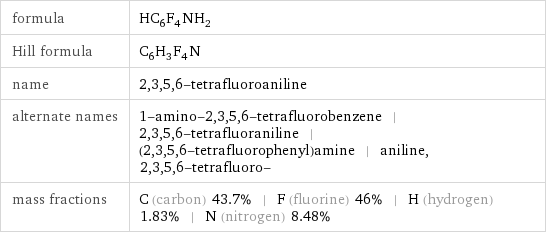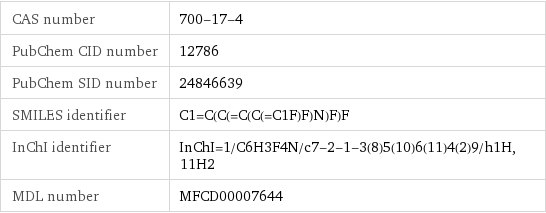Input interpretation

2, 3, 5, 6-tetrafluoroaniline
Chemical names and formulas

formula | HC_6F_4NH_2 Hill formula | C_6H_3F_4N name | 2, 3, 5, 6-tetrafluoroaniline alternate names | 1-amino-2, 3, 5, 6-tetrafluorobenzene | 2, 3, 5, 6-tetrafluoraniline | (2, 3, 5, 6-tetrafluorophenyl)amine | aniline, 2, 3, 5, 6-tetrafluoro- mass fractions | C (carbon) 43.7% | F (fluorine) 46% | H (hydrogen) 1.83% | N (nitrogen) 8.48%
Lewis structure

Draw the Lewis structure of 2, 3, 5, 6-tetrafluoroaniline. Start by drawing the overall structure of the molecule, ignoring potential double and triple bonds: Count the total valence electrons of the carbon (n_C, val = 4), fluorine (n_F, val = 7), hydrogen (n_H, val = 1), and nitrogen (n_N, val = 5) atoms: 6 n_C, val + 4 n_F, val + 3 n_H, val + n_N, val = 60 Calculate the number of electrons needed to completely fill the valence shells for carbon (n_C, full = 8), fluorine (n_F, full = 8), hydrogen (n_H, full = 2), and nitrogen (n_N, full = 8): 6 n_C, full + 4 n_F, full + 3 n_H, full + n_N, full = 94 Subtracting these two numbers shows that 94 - 60 = 34 bonding electrons are needed. Each bond has two electrons, so in addition to the 14 bonds already present in the diagram add 3 bonds. To minimize formal charge carbon wants 4 bonds. Identify the atoms that want additional bonds and the number of electrons remaining on each atom: Fill in the 3 bonds by pairing electrons between adjacent highlighted atoms. Note that the six atom ring is aromatic, so that the single and double bonds may be rearranged: Answer: | |
3D structure

3D structure
Basic properties

molar mass | 165.09 g/mol phase | solid (at STP) melting point | 31.5 °C boiling point | 158 °C density | 1.744 g/cm^3
Units

Solid properties (at STP)

density | 1.744 g/cm^3
Units

Chemical identifiers

CAS number | 700-17-4 PubChem CID number | 12786 PubChem SID number | 24846639 SMILES identifier | C1=C(C(=C(C(=C1F)F)N)F)F InChI identifier | InChI=1/C6H3F4N/c7-2-1-3(8)5(10)6(11)4(2)9/h1H, 11H2 MDL number | MFCD00007644
Safety properties

flash point | 62.78 °C

DOT numbers | 2941